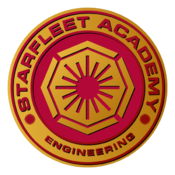
|
- Engineering Resources
- Components Engineering
- Propulsion Engineering
Edit this nav

|
Propulsion Systems Engineering
- ENG201: Impulse Systems
- A survey of modern impulse systems using fusion power and helium plasma. Students study the development of impulse technology and its use over the centuries, as well as modern impulse drives and their use aboard Federation starships. Simulations provide students with direct experience in operating and maintaining impulse drive systems, including emergency operations. A paper on the development of impulse in Federation history is required.
- ENG202: Introduction to Warp Systems
- The study of warp drive theory and development, from Zefram Cochrane to modern transwarp theories. Students study the design of warp drives, the formation of warp fields, and the potential effects of warp technology on normal space and subspace. Students experience developments in warp technology through a variety of simulations, including the original flight of the Phoenix and early Federation warp systems. A paper on the evolution and development of warp technology is required.
- ENG203: Advanced Warp Systems
- An in-depth study of warp drive technology and theory, including the structure of subspace, the formation of warp fields, subspace distortions and how they affect warp drive, and transwarp theories. Students study the operation, maintenance, and construction of warp drive systems using both simulation and hands-on experience. The class visits the Utopia Planitia Yards on Mars to examine the latest developments in warp technology. Students are expected to write a term paper on new developments in warp technology and to pass simulations on warp systems operations, including safety procedures during a warp core breach.
- Prerequisite: Introduction to Warp Systems, or Intermediate Electronics 2
- ENG301: Transwarp Theories
- A survey of the theoretical limits of warp propulsion and various theories for the achievement of transwarp, or warp factor 10. A vessel in transwarp would theoretically have infinite velocity and therefore occupy all points in space simultaneously. Students examine theories on the achievement of transwarp velocity, from the Excelsior experiments in 2284 to modern transwarp development projects at the Utopia Planitia Yards.
- ENG302: Alternative Faster-Than-Light Technologies
- A look at alternative methods of achieving interstellar travel, such as the soliton wave, the graviton catapult, and the quantum slipstream drive.
|

